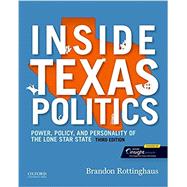The third edition of Inside Texas Politics--now Powered by the Oxford Insight Study Guide--provides an exciting insider's perspective on the world of Texas government. The book's focus on how power struggles have shaped Texas institutions and political processes offers a fresh perspective that differentiates it from all other texts on the market. Brandon Rottinghaus, a well-known political scholar, media commentator, and Dallas native, fills the text with his own insider anecdotes, making Inside Texas Politics, Third Edition, fun and relevant for today's students. The text's visual representations of data help students foster the skills they need in order to understand and think critically about the political world around them.
The accompanying Oxford Insight Study Guide works with the text to optimize learning. This powerful tool engages students in an active and highly dynamic review of chapter content, empowering them to critically assess their own understanding of core concepts presented in Inside Texas Politics. Real-time, actionable data generated by activity in the guide helps instructors ensure that each student is best supported along their unique learning path.








